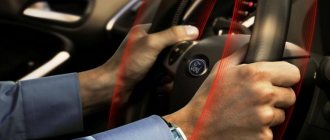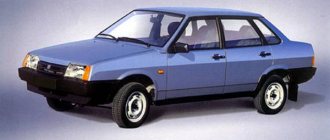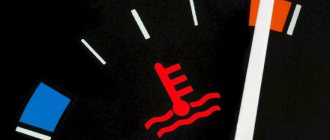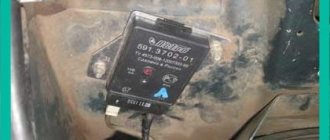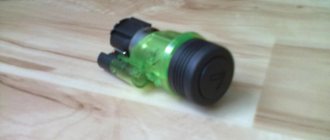Manifestation of the problem
As a rule, if the car jerks, this is usually due to various circumstances. Every driver should understand that any non-standard situations do not appear out of nowhere; this may be due to a malfunction of a particular system. In turn, this is usually due to wear and tear on vehicle components. And if you lose sight of this, sooner or later, it can result in serious and costly repairs.
As for when the problem begins to manifest itself, vehicle jerking can be noticed in the following cases:
- Only when the car starts moving.
- When the engine is running at low speed.
- During a sharp increase in speed.
- When the car is moving at high crankshaft speeds.
- In any mode of vehicle movement, which is manifested by periodic jolts at different times.
But what exactly can cause a vehicle to behave this way? When a VAZ-2114 jerks while driving, there may be several reasons for this, and quite a few. In fact, this is what we will discuss further.
Wheel imbalance
Wheels, like tires, although they have an ideal appearance, and even on rolling machines their shape is absolutely ideal, unfortunately, they have different densities of the material from which they are made. For example, the density of the alloy in the disk may differ in different places, which in turn will add or decrease weight in this place. The same is true with tires. Thus, when assembling the wheel, we get an imbalance caused by different weights in different places of the wheel as it rotates. Which in turn will lead to vibration in the steering wheel at speeds of approximately 80 km/h. This can be corrected by balancing the wheels at a tire shop.
Idle speed sensor
When the driver feels his vehicle begin to jerk, it makes sense to check the condition of the idle speed sensor. At the same time, such a malfunction is very difficult to identify, since often the well-known Check Engine indicator simply does not appear on the dashboard.
For this reason, it is worth checking it first. In this case, the nature of the malfunction may be different. Firstly, the sensor is contaminated with oil, dust, and crankcase gases. Secondly, you should not discount the mechanical nature of the damage - the rod, threaded connections, rivets flying out and other cases. Thirdly, this is a failure of the electrical part.
CV joint (grenade)
If you hear a knock when turning, and especially when the steering wheel is fully turned, this indicates a malfunction of the outer CV joint - constant velocity joint. The knocking noise occurs when the joint hits the wheel while turning. The inner CV joints crunch and knock without any turning. It is enough to be on an uneven road, or the car is driving at high speed. Characteristic crunching sounds indicate that the grenade is malfunctioning. If the CV joint fails, you should not try to repair it; you should completely replace this unit. If the hinge is in good condition, then it is enough to treat it with lubricant.
Supply system
As a rule, the main reason that the VAZ-2114 car jerks when driving is due to a malfunction of the power system.
Usually, experienced car enthusiasts and auto mechanics try to look for the cause here first, and they will be right. While the vehicle is starting to move, insufficient fuel may be supplied to the cylinders. This leads to the development of low power, which is not enough for full operation of the transmission.
In other words, if there is an uneven supply of the fuel-air mixture in the power unit, then it will simply not ignite well. In turn, because of this, the timing of the explosion is disrupted, and the heart of the car begins to malfunction. The driver feels this, which causes a lot of discomfort while driving. What can be done:
- Check the functionality of the hall sensor.
- Pay attention to the position of the throttle valve.
- The condition of the injectors also deserves attention.
In addition, to understand the reason why the VAZ-2114 injector twitches when driving, it is necessary to evaluate the condition of each element of the fuel system. Moreover, regardless of the type of power unit. As experts note, due to depressurization of the pipes, the engine experiences fuel starvation. This is manifested by failures in engine operation. Therefore, it is better not to neglect a thorough check of the pipes!
The last reason is the cardan transmission
The time has come to search for information on the Internet and using folk methods - I started asking auto mechanics and all my friends who have cars and had problems with the steering, what it could be and how to deal with it. There were a lot of assumptions, and completely remove the steering - then see what is there - but this would take a long time and would lead to large temporary losses. One day one of my friends recommended that I look at the small cardan transmission that is in the steering column. It is quite easy to carry out the inspection procedure; to do this, you need to remove the lower casing of the steering column and go down it down to the bend, where the steering column enters the car body, where the driveline is located. Pulling it, I discovered a slight shatter. After that, I removed the cardan transmission and, having disassembled it, discovered a wear there, which, as it turned out, created such a beating at speed. After replacing the cardan transmission, the beating went away - now the ride became comfortable.
Video about the causes of steering wheel vibration:
Source
Checking the ignition system
In some cases, the car starts to jerk due to some kind of malfunction in the ignition system. As a rule, the problem can be caused by untimely ignition of the fuel mixture. In rare cases, this is due to a weak spark from the spark plug, which in turn is due to low voltage supplied.
Why does the VAZ-2114 jerk when driving? To do this, during diagnostics it is necessary to check:
- First of all, the performance of the ignition coil.
- Serviceability of spark plugs (it is worth noting that if these elements malfunction, they are replaced as a complete set!).
- Pay attention to the condition of high-voltage wires.
- Are there any problems with the distributor (ignition distributor).
- Condition of the camshaft and crankshaft sensors.
And if the problem is the spark plug, then this is a fairly common and mild case. This type of breakdown is harmless and even a beginner can cope with it. Sometimes the problem may be caused by an incorrect gap between the spark plug contacts, which does not meet established standards.
But if the camshaft position sensor is to blame, then you won’t be able to start the engine at all. In this case, qualified assistance from specialists is necessary.
Unreliable wheel mounts
This problem is also easy to fix and diagnose. This is a simple but very dangerous reason. The fastenings can be loosened even on one wheel, and this is enough to cause shaking. If the problem is not resolved in time, emergency situations may occur. If the wheel falls off while driving, the repair will be quite expensive - you will have to replace the disc and hub, and the brake disc.
The symptoms in this case are very similar to vibrations due to tires or bent wheels. But there is a cyclical pattern here, although not at all speeds.
The accelerator also cannot be discounted
At the moment when the driver sharply presses the accelerator pedal, there is a rapid increase in crankshaft revolutions. However, this may cause the vacuum ignition angle regulators to malfunction. Ultimately, the distributor lags at low speeds, and the car begins to jerk.
As the crankshaft speed increases, the engine needs to work faster, igniting and admitting the fuel-air mixture. However, if there are problems with the vacuum regulators, there may be problems with opening the throttle valve and it will not be possible to quickly increase the speed. As a result, gasoline burns at the wrong time, which can damage the bearing responsible for the ignition timing.
To confirm or refute the problem when the VAZ-2114 jerks while driving, it is worth checking the vacuum regulators. Diagnostics is done like this: before starting the engine, you should remove all the pipes with hoses, first covering them with your hands. While the engine is running, you can hear the retractor effect of the regulators.
However, if a vacuum does not form during the working mixture, then the cause of the leakage lies precisely in the damper. The element needs to be replaced.
Vibration in the body and deformed rims
Often the cause of unpleasant vibrations is disc deformation. This is easily determined on balancing stands. Most often, deformations occur due to driving through potholes. The problem occurs in the spring, when their numbers increase.
If it is not possible to go to the stand, then you can try to find the dent visually. Most severely, the disc jams from the inside. Stamped steel wheels are more likely to deform than their cast counterparts.
In addition to dents, vibration at speeds of 100-120 km/h can also be caused by simply a curved disk. At the same time, the wheel can rotate smoothly on the stand. This is because it is attached to the device through the central hole. On a car, the wheel is not centered when installed. Warped discs also come from the factory.
Air filter?
As is known, the formation of an engine working mixture requires a certain amount of air in which oxygen is present. And without it, the combustion process itself is impossible. In a car, before entering the working chamber, the air passes through the labyrinths of the filter and only after that it combines with the fuel mixture, forming just the working composition.
However, if this element is contaminated, the car may also begin to jerk while driving or when starting off. As a result, the flow decreases significantly and there is simply no longer enough air in the required quantity. This risks the working mixture becoming rich in fuel and burning incorrectly.
As a result of this, the VAZ-2114 jerks when driving, and in some cases there may be misfires.
Ball joints
Ball joints are suspension elements. The durability of ball joints is affected by:
- The quality of the anthers that protect the assembly from dirt and dampness;
- Climatic conditions;
- Driving style;
- The quality of roads where the car is primarily used.
Naturally, in urban conditions, ball joints last longer.
During operation, the ball joint gradually wears down. And this grinding occurs the faster the sooner sand and other abrasive particles get under the boot. Ball joints must be regularly filled with oil, since the lubricant protects them from grinding and loosening. A knock when driving through holes is the first warning about the need to inspect the supports and replace them. The wobbling of the car when the wheel turns out should serve as a serious warning to the driver to take emergency measures.
Another filter - fuel
If everything is in order with the air filter, this does not mean that the fuel cell is “crystal clean”. It is worth checking its condition, because as you know, before the fuel enters the cylinder, where it then burns, releasing energy, it also undergoes cleaning. In most cases, this is also the main problem why the car starts to jerk.
The filter element serves to remove various impurities from the fuel, which do not disappear anywhere, but simply accumulate here. And over time, it begins to clog, and gradually its capacity begins to decrease. As a result, this also leads to “fuel starvation” of the engine. We already know its symptom - the car jerking.
The wheel alignment is broken
Directly depending on the incorrectly set angle, vibration can only occur during acceleration or in a certain speed range. Incorrect wheel alignment can be detected very quickly - tires wear unevenly.
If only the outer or only the inner part is wiped, then this is the same situation. The problem can be corrected by adjusting the angles. Then the vibration in the body at a speed of 100-120 km/h will disappear.
But the camber/toe has been adjusted, but the problem has not gone away. The angle has been corrected, that's a fact. But the car owner decided not to change the tires, because they can still drive. But the tires “drive” the way they are used to. This means that you need to change the tires or drive at low speeds for a period of time, then the tread will wear out evenly and the problem will be solved.
Checking filters
The fuel system of a modern car is equipped with at least three filters. The first of them is, in fact, just a mesh that serves to trap solid particles. It is placed in the neck of the tank, but it is not capable of becoming clogged to such an extent that fuel does not enter the cylinders. In this regard, this filter cannot be the reason that the VAZ-2114 twitches when driving.
The other element is mounted on the fuel pump, which is submerged in the tank. This is the same grid, only with smaller cells. However, the functions are basically the same - to retain large debris. For this reason, it is also clear that it is also not capable of becoming very clogged.
The third element is located after the fuel pump, and it is this filter (it serves for fine cleaning) that can become so clogged that the pump will one day stop coping with its duties.
At the same time, some models may have several additional filters installed. And they may well cause the car to jerk.
Wear or damage to suspension components
The wheel suspension includes many articulated elements, each of which has its own specific service life. These are oil seals, silent blocks, ball joints, bearings.
All of them operate within the permissible backlash, if exceeded, vibration of the steering wheel may occur at speeds of 90-100. There are a variety of ways to solve this problem: from diagnosing the chassis to troubleshooting the problem yourself. They are often complex and seriously damage the vehicle's chassis. Since the suspension is in constant motion, excess play (for example, a ball joint) leads to rapid loosening of the silent block of the lower suspension arm.
"Personal" motives
The cases listed above are the main reasons why the steering wheel twitches when driving a VAZ-2114. Moreover, this is observed when starting or accelerating. However, it should be taken into account that each vehicle has individual characteristics, which are comparable to the human body.
In other words, each car has its own “diseases” and the appearance of the “symptom” in question is precisely due to the presence of design flaws.
Even if car enthusiasts react quite nervously to such common phenomena as the rattling of glass and plastic inside a car, vibration of the steering wheel can put almost every driver in a mental hospital - this is a very annoying and unpleasant process. Jokes aside, vibrations on the steering wheel are a very serious problem. Today we will find out the reasons for its occurrence and tell you how to cope with this disaster.
Causes of vibrations on the steering wheel
As a rule, vibrations in the steering wheel appear under various conditions: when the car is moving at different speeds, braking, or when the car is stationary and its engine is idling. If the beating of the steering wheel has become annoying, you need to determine in what circumstances it manifests itself, and depending on this, diagnose the cause.
Steering wheel wobble when the car is stationary
Vibrations in this case can occur for two reasons: due to loose engine mounts or due to problems with the steering rack drive shaft. In the first option, when the engine is idling, the steering wheel hits quite hard. Such vibrations appear on cars with high mileage: either the mountings of the power unit have become loose over time, or the engine was not installed properly after a major overhaul. If even at low speeds a significant beating of the steering wheel is felt, then as the speed increases, the vibrations increase and driving such a car becomes not only uncomfortable, but also unsafe.
The second option: the occurrence of vibrations at idle speed in a stationary car can be caused by wear of the splined part of the steering rack drive shaft or deformation of the shaft itself. With this option, the steering wheel runout may also increase when the car moves.
You cannot drive with such vibrations for a long time because it can lead to destruction of the steering mechanism elements, and, as a result, loss of control of the car - an accident.
Steering wheel vibration when driving at different speeds
Here there are more factors causing vibrations, and they are mainly related to the condition of the wheels.
Firstly, steering wheel beating can occur due to the fact that the wheel rims become clogged with snow or dirt, which leads to imbalance of the wheels and, as a result, the appearance of those same annoying vibrations. In this case, the steering wheel only shakes at low speeds, and when the speed increases, the vibrations disappear completely.
Why does the steering wheel shake? 7 Main Causes of Steering Wheel Vibration
Care and attention to the technical condition of the car is our direct responsibility. And it doesn’t matter how we feel about it, whether it’s a “workhorse” for us, a means of transportation or a luxury item. First of all, its serviceability is our safety.
And one of the reasons to pay serious attention to your car is the vibration of the steering wheel when driving, or, as experienced drivers say, the beating of the steering wheel. It is expressed in completely different ways and at different speeds, for some at 30 km/h, and for others at 70 km/h. It doesn't really matter. What matters is the fact that there is something wrong with the mechanical part of the car. Let's look together at the seven main causes of this vibration and how to eliminate them. And I’ll tell you about another interesting reason, which is rare, at the end.
Driving in a straight line at low speeds
There are also reasons for steering wheel beating that manifest themselves exclusively when driving at low and medium speeds. Again, we should not exclude the defects already discussed, just like those described below in other sections.
Reason #10. Disc deformation
A fairly common cause of steering wheel wobble at low and medium speeds. Most likely, even novice drivers do not need to explain in detail what deformation is and where it comes from. With our famous roads this is almost a “number uno” problem.
Finding the cause is simple and involves a visual inspection of the wheel rims. Particular attention is paid to those places where the tire “sits” on the rim. This place is called the rim of the wheel, and it is this place that is the first to suffer from hitting potholes and other road irregularities. We must also not forget that a wheel rim, no matter how strange it may sound, has two sides - outer and inner. So, the inner side is often forgotten, never looking at it. Meanwhile, according to the law of meanness, deformations, which are a common cause of steering wheel beating, are located exactly there.
Repair here is simple and relatively inexpensive, if the disk is not in the trash. A common procedure called rolling returns the wheels to a perfect circle shape, and the vibrations may well disappear completely. Of course, it will be a little more difficult and more expensive for those who have cast or forged wheels. Even if these are subject to rolling, it is done with difficulty, for which specialists want appropriate payment. There are never any problems with steel discs, unless they burst.
When preparing this material, information was found on the Internet that stamped steel disks are sometimes even leveled to perfection using a sledgehammer. Who knows, maybe we have such daredevil blacksmiths, but in the (subjective) opinion of the author, trusting such craftsmen with the wheels of your car is a bad idea...
Reason #11. Unadjusted camber and toe
Here, too, apparently, nothing special needs to be explained. Suffice it to say that wheels “looking” in different directions is a sure cause of steering wheel vibration. The problem appears more often during acceleration and when driving at low speeds. When a significant speed is reached, it usually disappears temporarily.
Diagnosis is simple if the case is very advanced. Crooked wheels are visible to the naked eye. In any case, even if the deviation is not visible without equipment, it will not be possible to adjust the camber and toe without them. It doesn't work by eye here. Therefore, if you have any suspicions about this, or simply haven’t had your camber and toe-in adjustments done for a long time, contact the appropriate service. The procedure is not so expensive that you would waste money on performing it at least twice a year.

